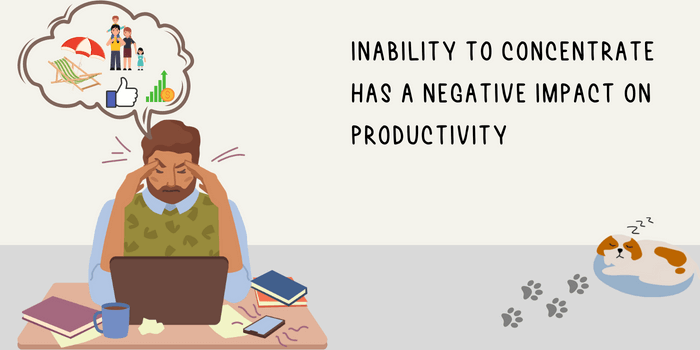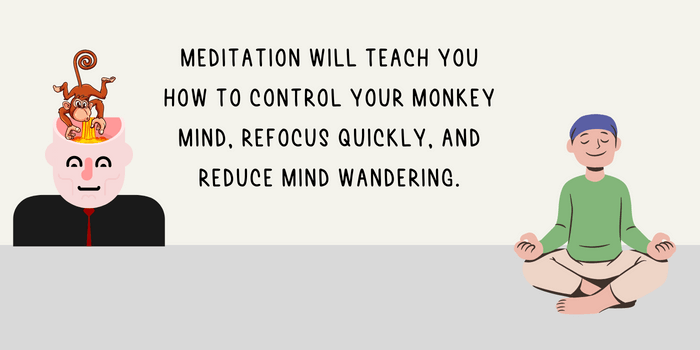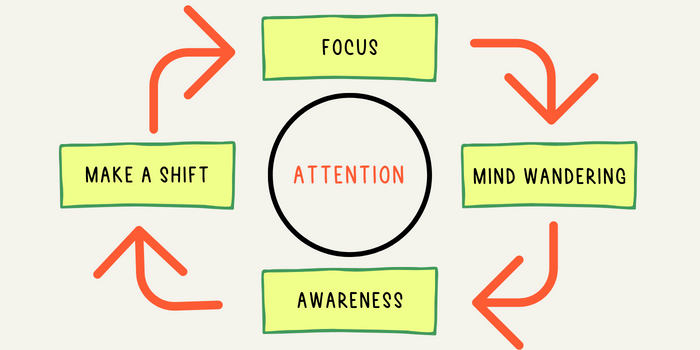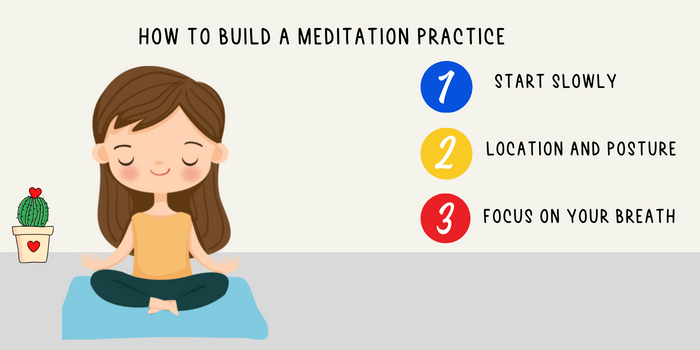Whenever I sit down to prepare an expense report, my brain presents me with a list of several other urgent things that I need to do, and I struggle to maintain focus.
In fact, I’ve noticed this surge of distracting thoughts whenever I start working on something that I don’t particularly like or if the task feels too difficult. All of a sudden, my brain is flooded with so many more interesting and useful things I could be doing instead.
I bet you’ve had similar experiences in your own life. In the entire history of humankind, as a society we have never been as distracted as we are now.
Inability to focus has a serious impact on your productivity, and consequently on your studies and your career. Being constantly distracted has disastrous effects on your personal relationships as well.
There are many techniques to improve attention and focus, but in this article I will discuss perhaps the most effective practice of all – meditation.
Some people think meditation is something that only monks do. Others see it as a recreational retreat done for a short duration, which has no practical application in the realities of the workplace. But the fact is that meditating regularly has a real impact in improving your focus and productivity.
But isn’t meditation spiritual?
No, meditation is not just about spiritual experiences or monks and yogis. Rather, its efficacy and applications are evidence-based and rigorously tested in laboratory settings.
In the US, there is an organization called the Mind and Life Institute that conducts intensive dialogues between scientists and the Dalai Lama on a wide range of topics. In 2000, during one such discussion, the Dalai Lama challenged the scientists to take some time-tested contemplative practices from his tradition and test them rigorously at the lab. Freed from religious trappings, if these practices turned out to be useful to help people tame their destructive emotions, he urged that they be spread widely across the world. [1]
This catalyzed research on useful and evidence-based applications of mindfulness and meditation, ranging from stress reduction to improving focus. This “wide path” of meditation is not the intensive practice of a monk, but is very accessible and has practical benefits to laymen from all walks of life.
One of the key benefits of regular meditation is improving the ability to retain focus for long periods of time.
Now let’s look at the perpetually distracted and chaotic part of our mind.
The monkey mind
We all have a constant inner chatter going on. It’s a voice that sounds something like this:
“That was such a stupid thing to say. So stupid!”
“My hair looks awful.”
“How could she do that to me? So unfair!”
This persistent chatter is what the Buddhists call the Monkey Mind, and science calls the Default Mode Network (DMN).
Our Default Mode Network is activated when we’re resting or doing nothing [2]. It is related to internally driven processes like self-referential thinking, imagining the future, retrieving autobiographical memories etc. It also helps process constantly incoming external information [3].
The Buddha described the mind as full of drunken monkeys, always creating chaos and jumping from one thought to another.
In the modern world, it is harder than ever before to hold our attention on anything. There is always something or the other that distracts us from what we’re currently doing. In such attentional state fluctuations, DMN activity is noted to be higher [4].
Lower DMN activity is associated with successfully performing cognitive tasks aimed at achieving specific goals [5], for example, working on an important project.
Meditation has been shown to reduce Default Mode Network activity [6]. Practising meditation is therefore an effective way to keep spontaneous DMN activity or attentional state fluctuations in check.
Meditation will show you how to tame the monkey mind, help refocus quickly, and reduce mind-wandering.
4 phases of attention and distraction
If you want to improve your focus, you must first notice how you lose it.
Every time you try to focus, there are 4 distinct phases of attention and distraction that you go through [7].
Phase 1: You choose a focus
Let’s say, at work you are trying to shortlist a few people to interview for a new role. Your task is to go through the resumes of all applicants and select a few that make the cut.
Phase 2: Your attention wanders
After some time, your attention naturally wanders. Mind wandering is the brain’s default process and it happens about 50% of our waking time [8]. It’s simply how we’re wired and not something we can plan or choose.
Phase 3: You realize that your mind has wandered
The next phase is when you notice the distraction. It’s when you realize with a start that you were supposed to be checking resumes, but instead you were daydreaming about that amazing vacation that you took last week.
Phase 4: You make a choice
Now that you have realized that your attention is far away from where it was supposed to be, you must now make a choice. You may choose to return to your task, or you may give up and do something else.
If you do return to the original task, the whole cycle repeats. Your attention will wander, you will notice, and then you’ll make the choice to either bring your focus back on the task or give up.
Only phases 1 and 4 are within your control and your conscious choice. Phases 2 and 3 – the mind wandering and the noticing – just happen.
If you start paying attention to these 4 phases as they happen over and over again, you will soon notice that your ability to stay with the original focus becomes longer, and when your mind wanders you realize that faster. You will also choose to return to the task more often than giving up and doing something else.
The very act of noticing the distraction and its structure gradually strengthens your ability to stay focused and beat distractions. This is exactly what meditation helps you do.
Meditation trains you in
- Concentrating on a specific object
- Noticing your thoughts
- Noticing when your focus or attention has shifted
- Being okay with the shift in attention wandering
- Bringing it back to the desired point of focus
- Keeping the focus there as long as you can
This is at the root of all kinds of meditation practice. Meditation is essentially attentional training. Just like building your biceps at the gym, the right kind of meditation can help strengthen your attention muscle.
What you must remember though is that you can never completely eliminate all distractions. That’s an impossible goal. Rather, as you meditate, the goal is to start noticing the distracting thoughts and gently bring awareness back to the present.
“A universal goal in meditation of every kind comes down to sustaining attention in a chosen way or to a given target, such as the breath. Numerous reports, both anecdotal and scientific, support the idea that meditation leads to better sustained attention, or, to use the technical term, vigilance.”
Excerpt From: Daniel Goleman. “The Science of Meditation”
Reduce attentional blink through meditation
Our brain has limited resources, so the attentional bandwidth is allocated frugally. The most attention goes to what we choose to focus on at the moment. So much so that when we shift our focus from one thing to another, there is a small gap in our attention which makes it hard for us to notice two stimuli in quick succession.
This is called attentional blink, or basically the amount of time it takes for us to notice the second stimuli after the first. The concept is beautifully explained in this video.
Cognitive scientists used to believe that attentional blink was hardwired and nothing could change that. But when they tested vipassana meditators before and after a 3 month retreat, they found that there was a 20% reduction in attentional blink after the retreat [9]. The meditators were able to keep their minds calm enough to better notice the second stimuli, even if it immediately followed the first.
You can imagine the enormous impact of this level of focus in occupations like air traffic controllers, pilots etc.
How to build a meditation practice
I have covered this topic in detail in the complete guide to meditation for beginners. But here’s a quick summary on how you can build a meditation practice that will improve your ability to concentrate.
Start slowly
If you are a beginner, start with just 5 minutes of meditation a day. You can gradually increase the time over several weeks.
Location and posture
Find a comfortable spot in your home, where you can sit comfortably without getting disturbed. Sit on the floor on a cushion, or on a chair – whatever works for you. If your back needs support, get something for that.
What to do
The best way to start is by developing single pointed concentration which focuses on an object. The most easily accessible object that is always with us is our breath, so we can choose to focus on our breathing.
Focus on your in-breath and out-breath. Start counting each breath, just before the in-breath.
One
Breathe in… Breathe out…
Two
Breathe in… Breathe out…
…
Count up to 10, and start from 1 again.
If you notice that your attention has wandered (as it will) or that you have lost count, gently bring your attention back and start from 1 again.
The whole point of meditation is to start noticing the mind wandering and to gently bring it back to the point of focus. This is what helps you become more aware and present in the moment.
Here is a 10-minute guided meditation session that you can use.
At HabitStrong, our Become A Morning Person bootcamp helps you build a daily meditation practice. The external accountability of the bootcamp and live guided meditation sessions will help you stick to the practice and make it part of your morning routine.

Become A Morning Person Bootcamp
For calm mornings with a daily meditation & journaling routine
I hope this article has shown you how you can use meditation to build your focus and improve concentration.
A daily meditation practice is one of the most transformative life habits that you can build. Ability to focus better is just one of the many benefits of this life-changing practice.
I hope you feel encouraged enough to try. Good luck.
***
Sources
[1] Altered Traits: Science Reveals How Meditation Changes Your Mind, Brain, and Body by Daniel Goleman and Richard J. Davidson
[2] https://www.sciencedirect.com/topics/neuroscience/default-mode-network
[3] https://www.nature.com/articles/s42003-020-01602-z
[4] https://www.pnas.org/doi/10.1073/pnas.1611743113
[5] https://www.cns.nyu.edu/wanglab/publications/pdf/anticevic_tics2012.pdf
[6] https://www.ncbi.nlm.nih.gov/pmc/articles/PMC4529365/
[7] Focus (HBR Emotional Intelligence Series)
[8] https://www.sciencedirect.com/topics/psychology/mind-wandering
[9] Slagter HA, Lutz A, Greischar LL, Francis AD, Nieuwenhuis S, Davis JM, Davidson RJ. Mental training affects distribution of limited brain resources. https://www.ncbi.nlm.nih.gov/pmc/articles/PMC1865565/




